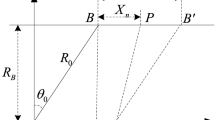Abstract
With the improvement of SAR resolution, super-resolution SAR imaging is more and more widely used in the all-time and all-weather video surveillance and remote sensing imaging. One implementation of super-resolution SAR is that radar works in the spotlight mode. In the case with highly squinted angle and acceleration, the azimuth space variance and the coupling between range and azimuth will become serious in super-resolution imaging. Thus, an azimuth frequency nonlinear chirp scaling algorithm is proposed to solve this problem. Based on the acceleration model, the accurate 2-D spectrum is performed by adopting the method of series reversion. The space-variance of missile-borne SAR in curved flight path is analyzed and an azimuth polynomial phase filter is constructed to make the coefficients of the perturbation function has sufficient flexibility to eliminate the spatial-variant couple terms between range and azimuth. In addition, the gradient operation is used to expand the space-variant coefficients of azimuth modulation term, and the perturbation function is applied to eliminate the space-variant in azimuth direction. The proposed focusing method can process the missile-borne SAR data obtained in spotlight mode in highly squinted angle with high efficiency. The simulation results verify the effectiveness of the proposed imaging approach. The integration of the research in this paper and the deep learning will further pave the way of super-resolution SAR imaging applications in disaster monitoring, security and surveillance.






Similar content being viewed by others
References
Cumming, I.G., Wong, F.H.: Digital processing of synthetic aperture radar data: algorithms and implementations. Artech House, Boston (2005)
Carrara, W.G., Goodman, R.S., Majewski, R.M.: Spotlight synthetic aperture radar: signal processing algorithms. Artech House, Norwood (1995)
Zhao, P.F., Deng, Y.K., Wang, W., Liu, D.C., Wang, R.: Azimuth ambiguity suppression for hybridpolarimetric Syntheticaperture radar viawaveform diversity. Remote Sens. 12(7), 1226 (2020)
Mittermayer, J., Moreira, A., Loffeld, O.: Spotlight SAR data processing using the frequency scaling algorithm. IEEE Trans. Geosci. Remote Sens. 37(5), 2198–2214 (1999)
Gorham, L., Rigling, B.: Fast corrections for polar format algorithm with a curved flight path. IEEE Trans. Aerosp. Electron Syst. 52(6), 2815–2824 (2017)
He, F., Chen, Q., Dong, Z.: Processing of ultrahigh-resolution spaceborne sliding spotlight SAR data on curved orbit. IEEE Trans. Aerosp. Electron Syst. 49(2), 819–839 (2013)
An, D.X., Huang, X.T., Jin, T.: Extended nonlinear chirp scaling algorithm for high-resolution highly squint SAR data focusing. IEEE Trans. Geosci. Remote Sens. 50(9), 3595–3609 (2012)
Guo, J., Chen, J., Liu, W., Li, C., Yang, W.: An improved airborne multichannel SAR imaging method with motion compensation and range-variant channel mismatch correction. IEEE J. Sel. Top. Appl. Earth Obs. Remote Sens. 13, 5414–5423 (2020)
Li, Z., Liang, Y., Xing, M.: An improved range model and omega-k based imaging algorithm for high-squint SAR with curved trajectory and constant acceleration. IEEE Geosci. Remote Sens. Lett. 13(5), 656–660 (2016)
Tang, S.Y., Zhang, L.R., Guo, P.: Acceleration model analyses and imaging algorithm for highly squinted airborne spotlight-mode SAR with maneuvers. IEEE J. Sel. Top. Appl. Earth Obs. Remote Sens. 8(3), 1120–1131 (2017)
Li, Z., Xing, M., Xing, W.: A modified equivalent range model and wavenumber-domain imaging approach for high-resolution-high-squint SAR with curved trajectory. IEEE Trans. Geosci. Remote Sens. 55(7), 3721–3734 (2017)
Zeng, T., Li, Y.H., Ding, Z.G.: Subaperture approach based on azimuth-dependent range cell migration correction and azimuth focusing parameter equalization for maneuvering high-squint-mode SAR omega-K algorithm for highly squinted missile-borne SAR with constant acceleration. IEEE Trans. Geosci. Remote Sens. 53(12), 6718–6734 (2015)
Mao, X., Zhu, D., Zhu, Z.: Polar format algorithm wavefront curvature compensation under arbitrary radar flight path. IEEE Geosci. Remote Sens. Lett. 9(3), 526–530 (2012)
Liang, Y., Dang, Y., Li, G., Wu, J., Xing, M.: A two-step processing method for diving-mode squint SAR imaging with subaperture data. IEEE Trans. Geosci. Remote Sens. 58(2), 811–825 (2020)
Li, G., Ma, Y., Shi, L., Hou, J.Q.: KT and azimuth sub-region deramp-based high-squint SAR imaging algorithm mounted on manoeuvring platforms. IET Radar Sonar Navig. 14, 388–398 (2020)
Tang, S.Y., Zhang, L.R., Guo, P., Zhao, Y.H.: An omega-K algorithm for highly squinted missile-borne SAR with constant acceleration. IEEE Geosci. Remote Sens. Lett. 11, 1569–1573 (2014)
Li Y.L., Liang D.N.: A refined range Doppler algorithm for airborne squinted SAR imaging under maneuvers. In: 2007 1st Asian and Pacific Conference on Synthetic Aperture Radar, IEEE 389–392 (2007)
Raney, R.K., Runge, H., Bamler, R., Cumming, I.G., Wong, F.H.: Precision SAR processing using chirp scaling. IEEE Trans. Geosci. Remote Sens. 32(4), 786–799 (1994)
Moreira, A., Mittermayer, J., Scheiber, R.: Extended chirp scaling algorithm for air- and spaceborne SAR data processing in stripmap and ScanSAR imaging modes. IEEE Trans. Geosci. Remote Sens. 34(5), 1123–1136 (1996)
Davidson, G.W., Cumming, I.G., Ito, M.R.: A chirp scaling approach for processing squint mode SAR data. IEEE Trans. Aerosp. Electron Syst. 32, 121–132 (1996)
Liu, G.G., Li, P., Tang, S.Y.: Focusing highly squinted data with motion errors based on modified non-linear chirp scaling. IET Radar Sonar Navig. 7(5), 568–578 (2013)
Funding
This research was funded by the National Natural Science Foundation of China (62071359), China Postdoctoral Science Foundation (2016M602770), Scientific Research Program Funded by Shaanxi Provincial Education Department (19JK0673), Natural Science Basic Research Plan in Shaanxi Province of China (2019JQ-405), Postdoctoral Science Foundation in Shaanxi Province and the Fundamental Research Funds for the Central Universities (XJS190209).
Author information
Authors and Affiliations
Contributions
TQ and YZ performed conceptualization; methodology and also involved in writing—original draft preparation; writing—review and editing. YZ was involved in validation and formal analysis.
Corresponding author
Ethics declarations
Conflict of interest
The authors declare no conflict of interest.
Additional information
Publisher's Note
Springer Nature remains neutral with regard to jurisdictional claims in published maps and institutional affiliations.
Rights and permissions
About this article
Cite this article
Qu, T., Zhang, Y. & Wu, J. A novel AFNCS algorithm for super-resolution SAR in curve trajectory. Multimedia Systems 27, 837–844 (2021). https://doi.org/10.1007/s00530-020-00715-z
Received:
Accepted:
Published:
Issue Date:
DOI: https://doi.org/10.1007/s00530-020-00715-z




